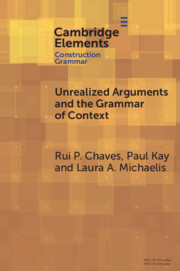Refine search
Actions for selected content:
291 results
21 - Medical and Scientific Writing
- from Part III - Genre and Medium in the Record
-
-
- Book:
- The New Cambridge History of the English Language
- Print publication:
- 16 October 2025, pp 506-533
-
- Chapter
- Export citation
Chapter 9 - Bizarre Cases and Context
- from Part II - A Kantian Account of Thought Experiment
-
- Book:
- Kierkegaard and the Structure of Imagination
- Published online:
- 26 September 2025
- Print publication:
- 16 October 2025, pp 138-154
-
- Chapter
- Export citation
Chapter 10 - Body of Knowledge
- from Section III - Emotion Perception and Elicitation
-
-
- Book:
- The Cambridge Handbook of Human Affective Neuroscience
- Published online:
- 16 September 2025
- Print publication:
- 02 October 2025, pp 207-218
-
- Chapter
- Export citation
Chapter 1 - Context, history and regulation
-
- Book:
- Contemporary Australian Corporate Law
- Published online:
- 11 September 2025
- Print publication:
- 25 September 2025, pp 1-51
-
- Chapter
- Export citation

Unrealized Arguments and the Grammar of Context
-
- Published online:
- 31 July 2025
- Print publication:
- 04 September 2025
-
- Element
- Export citation
Contextual variations in the effects of social withdrawal, peer exclusion, and friendship on growth curves of depressed affect in late childhood
-
- Journal:
- Development and Psychopathology , First View
- Published online by Cambridge University Press:
- 30 June 2025, pp. 1-12
-
- Article
-
- You have access
- Open access
- HTML
- Export citation
2 - Impact of Context
- from Part I - Laying the Foundations
-
-
- Book:
- The Cambridge Handbook of Technology in Language Teaching and Learning
- Published online:
- 15 June 2025
- Print publication:
- 26 June 2025, pp 16-32
-
- Chapter
- Export citation
Inferring welfare from inconsistent choices: how values matter
-
- Journal:
- Economics & Philosophy , First View
- Published online by Cambridge University Press:
- 19 May 2025, pp. 1-24
-
- Article
-
- You have access
- Open access
- HTML
- Export citation
8 - The Importance of Context in Analysing the Incitement of Violence
- from III - The Dark Side of Persuasion
-
-
- Book:
- Manipulation, Influence and Deception
- Published online:
- 10 June 2025
- Print publication:
- 24 April 2025, pp 157-176
-
- Chapter
- Export citation
Appendix D - A Syntactic Description of Free n-Categories
- from Appendices
-
- Book:
- Polygraphs: From Rewriting to Higher Categories
- Published online:
- 18 March 2025
- Print publication:
- 03 April 2025, pp 572-583
-
- Chapter
- Export citation
16 - Properties of the Category of n-Polygraphs
- from Part IV - Polygraphs
-
- Book:
- Polygraphs: From Rewriting to Higher Categories
- Published online:
- 18 March 2025
- Print publication:
- 03 April 2025, pp 327-348
-
- Chapter
- Export citation
Neutral versus loaded instructions in a bribery experiment
-
- Journal:
- Experimental Economics / Volume 9 / Issue 2 / June 2006
- Published online by Cambridge University Press:
- 14 March 2025, pp. 103-121
-
- Article
- Export citation
Chapter 22 - Standing on the Shoulders of Giants while Frantically Learning to Swim
-
-
- Book:
- Pillars of Developmental Psychology
- Published online:
- 14 February 2025
- Print publication:
- 20 February 2025, pp 245-255
-
- Chapter
- Export citation
Chapter 33 - Change and Continuity in the Life of a Developmental Psychologist
-
-
- Book:
- Pillars of Developmental Psychology
- Published online:
- 14 February 2025
- Print publication:
- 20 February 2025, pp 373-382
-
- Chapter
- Export citation
Crossing the cultural bridge: The role of inhibitory control during second language metaphor comprehension
-
- Journal:
- Bilingualism: Language and Cognition , First View
- Published online by Cambridge University Press:
- 19 February 2025, pp. 1-17
-
- Article
-
- You have access
- Open access
- HTML
- Export citation
Context and preferences for equality in the spectator game
-
- Journal:
- Journal of the Economic Science Association / Volume 9 / Issue 2 / December 2023
- Published online by Cambridge University Press:
- 17 January 2025, pp. 227-238
-
- Article
-
- You have access
- Open access
- HTML
- Export citation
8 - Strategy and Organizational Forms
- from Part III - Executing Strategy in a Global Context
-
- Book:
- International Management Behavior
- Published online:
- 15 March 2025
- Print publication:
- 16 January 2025, pp 273-309
-
- Chapter
- Export citation
3 - Culture: The Context of Meaning in International Management
- from Part I - The New Global Context
-
- Book:
- International Management Behavior
- Published online:
- 15 March 2025
- Print publication:
- 16 January 2025, pp 58-82
-
- Chapter
- Export citation
Chapter 3 - Communication as a process
- from Part 1 - Understanding communication
-
- Book:
- Communication Skills for Business Professionals
- Published online:
- 25 February 2025
- Print publication:
- 15 January 2025, pp 54-75
-
- Chapter
- Export citation
Chapter 4 - What Is the Role of Context in an Analysis?
-
- Book:
- Introducing Practical Discourse Analysis
- Published online:
- 20 December 2024
- Print publication:
- 09 January 2025, pp 97-126
-
- Chapter
- Export citation
